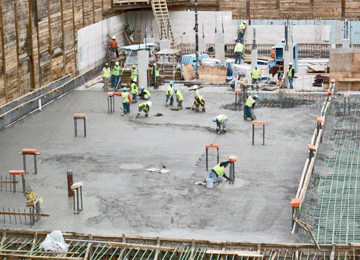Effects of Hot Weather on Concrete
The most pronounced effects of hot weather on concrete are increased setting rates and rapid water loss. Higher temperatures can cause a lower slump, and consequently a decrease in workability. Shrinkage and cracking of placed and finished concrete is usually associated with hot, windy weather and is most often the result of rapid moisture evaporation from the concrete surface. Although initial strength may be accelerated by hot weather curing, the 28-day strength of concrete cured at elevated temperatures may be lower than concrete cured at moderate temperatures.
Adding water can increase concrete workability
However, adding too much water – in quantities beyond the amount required by the approved mix design – increases the water to cement ratio. This, in turn, can result in decreased compressive strength and an increased likelihood of cracking.
Hot Weather Concrete Construction Practices
Several basic precautions can reduce the damaging effects of hot weather on concrete:
- Use mix designs that are less susceptible to the effects of hot weather. The use of low-heat-of-hydration cement and certain admixtures (such as hydration retarding and/or water-reducing admixtures) are two common approaches.
- Keep concrete as cool as reasonably possible. ACI 305R does not state a maximum “as-placed” or “as-delivered” concrete temperature, but 90 degrees F is commonly used. Substituting chilled water or shaved or chipped ice for a portion of the required mix water can help.
- Schedule large concrete pours in the early morning or evening when temperatures are cooler.
- Limit the amount of time between loading the concrete at the plant and placement / finishing at the site.
- Limit water addition at the job site, except to adjust slump upon arrival (when permitted by mix design).
- Avoid or limit hydration accelerating admixture use.
- Use temporary wind screens and water misting nozzles to reduce surficial moisture loss.
Curing Concrete Techniques for Hot Weather
Once concrete has been placed and finished, efforts must continue to protect the curing concrete. Initial curing is critical for concrete strength and quality. The most effective technique is moist curing – continuously wetting the surface. Moist curing is also effective in developing maximum concrete strength potential and reducing shrinkage cracking. While curing compounds are popular and may be effective, they must be sprayed on evenly and in sufficient quantity to be effective. Curing compounds are typically not used for indoor floors due to potential finished flooring adhesion compatibility issues.
Planning for Hot Weather Concrete Placement
Detailed planning for hot weather concrete is essential. A pre-placement meeting is recommended to clarify requirements to address the wide range of possible actions and to define responsibilities. The American Concrete Institute’s publication ACI 305R is also an excellent reference.

